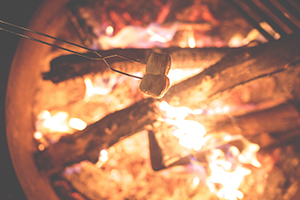 Fire pits are a fantastic addition to your home’s outdoor entertaining space—and one of the best ways to end an evening. As a top requested backyard feature for homeowners, fire pits are attractive and inexpensive to use but also carry a lot of risk. The key to having fun is staying safe because when you use a fire pit, you are literally playing with fire.
Fire pits are a fantastic addition to your home’s outdoor entertaining space—and one of the best ways to end an evening. As a top requested backyard feature for homeowners, fire pits are attractive and inexpensive to use but also carry a lot of risk. The key to having fun is staying safe because when you use a fire pit, you are literally playing with fire.
The following safety precautions will help prevent careless misuse that could not only set your own house ablaze, but could also endanger others nearby.
Determining the best fire pit location
Whether using a portable fire pit or installing a permanent one, the proper positioning is key to safety. Consider the following when selecting your fire pits location:
- Make sure you use a level surface in an open area with a minimum distance of 10 feet from any structures and overhanging branches. Check your local ordinances to ensure you observe the distance required by law.
- Always place a fire pit on a non-flammable, flat surface, such as patio blocks or concrete.
- Never put a fire pit on a wooden deck or directly on grass.
Preparing the fire pit
Before using a fire pit, always take time to prepare the area before lighting anything.
- Clear any flammable materials away from the fire pit before using it. A good rule of thumb is to keep a five-foot distance between any vegetation or grass to create a break-zone to help prevent any escaped embers from spreading.
- Keeping dirt or rock piles around the pit will also help keep the fire contained.
- The pit should be at least six inches deep in the center and two feet in diameter to help control the embers and flames.
Lighting the fire pit
- Always check the weather report and burn status. If pollution levels are high or the area is in a drought, there may be “no burn” restrictions in place.
- Also, monitor the wind direction before lighting the fire. Remove anything flammable downwind of the pit and if it is too windy, refrain from using it until the wind calms.
- Never use lighter fluid, other flammable fluids (gasoline, etc.) or accelerants to light or relight fires. These options could release toxic fumes, start an explosion or cause your fire to grow too quickly. A commercial fire starter stick with kindling on top is ideal for safety.
Using the fire pit
- Never leave a fire pit unattended. Children and pets should never be left alone with the fire.
- Consider investing in a fire pit screen to keep your fire in the pit. This will help prevent errant embers and sparks from escaping. When purchasing a screen, be sure to choose a heat-resistant metal like cast iron or steel.
- Don’t put trash or other paper products in the fire; they can easily spark producing flying embers or burning remnants.
- Refrain from wearing flammable or loose-fitting clothing while near the pit.
- Only certain woods are suitable to burn. Never use pressure-treated wood, particleboard, laminated, stained or painted wood. Seasoned hard woods like hickory are best for burning, whereas softer woods like pine or cedar can pop and throw sparks.
- Accidents can always happen, even if you follow all of these guidelines, so keep a container of water and a hose nearby in case of an emergency.
Extinguishing the fire pit
- A shovel will help extinguish any escaped flames and put out the fire itself.
- When you’re done using the fire pit, extinguish with plenty of water to drown it out. Then, stir it with a shovel to make sure it’s fully extinguished. Continue dousing it with water until every ember is gone.
- Even after two or three days, ashes could still be hot enough to cause a fire. If you choose to dispose of the ashes, do so in a safe manner, such as using a metal can solely for ash storage.
- Never discard hot ashes in a compost pile, paper bag, cardboard box or anything that is combustible.
By following these guidelines and safely utilizing your fire pit, you can enjoy your fire with friends, family and peace of mind all year-round.